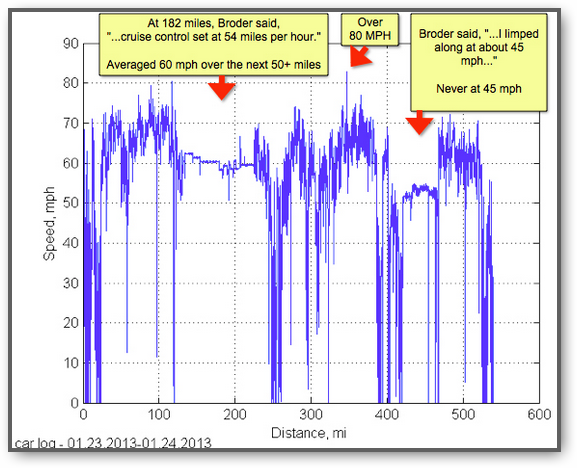This is the first installment of our co-founding editor John C. Dvorak’s Tech Stock Corner here at its new and permanent home at aNewDomain.net. A lot has happened since the New York Times on Feb. 5 slammed Tesla Motors’ Tesla S in a review — John rounds up the latest news in the controversy, explains the issues Tesla faces, what speed and battery life have to do with the bad and good reviews. Better still, he’s got a great idea of who will probably buy Tesla. As the stock sinks, someone’s going to get a real bargain.
aNewDomain.net — Two things happened since the Tesla vs The New York Times brouhaha broke out back in early February 5. That’s when NYT reporter John Broder slammed it. Scroll below for details on that story. Because now there’s more.
Of late, we’ve got Tesla CEO Elon Musk complaining that, somehow, the damaging review cost the company $100 million U.S. Some reports go far as to say the March 5 layoffs of Tesla workers are directly related to that one damaging article.
And then, we’ve got Silicon Valley venture capitalist Tim Draper joining other loud defenders of the Tesla cause. He came out with a statement saying the Tesla is the greatest car he ever owned. He said he’d never buy anything again that wasn’t a Tesla.
Below, extremism visualized: Check out the graphic below and scroll below for more John C. Dvorak’s tale on what happened here on why other reviewers from CNN, BBC and others didn’t run into the NYT problem causing Tesla so much damage.

The whole episode began in early February with a NYT casual test drive of the Tesla Model S sedan. It’s a striking electric car that purports to have a range of 265 miles before you need to recharge.
The NYT reporter, Broder, tried to make it from Washington D.C to Boston but couldn’t, he says, despite all the charging stations along the way.
Tesla Motors stock dove during this debacle.
The problem appears to be quite simple: The test driver cum reporter Broder just drove too fast. Broder claims he set the speed limit on the cruise control at 54 miles per hour. Not so, says the computer black box in his car. It shows he drove 65 to 81 miles per hour through some if not most of the trip.
I tend to believe the black box which confirms my own experiences test driving cars. The Tesla Model S is one of those cars that glides at 80. It’s smooth. So you do what anyone would do — you do 80.
Now, a CNN test driver tried the same trip — but he was more conscientous about the speed, apparently — and he made the same Washington to Boston trip with plenty of juice left over.
A good back-and-forth to get you up to speed on this nutty controversy is at the NYT blog, here. .
I should add that a similar scenario played out with the Tesla roadster on the BBC show Top Gear. Host Jeremy Clarkson ran though the batteries in just a few miles while racing the car around a short track. Tesla Motors turned around and sued the BBC for faking the test. But in the end, anyway, nobody believed the BBC faked anything.
Everyone knows batteries act differently when they are under a load.
So this is the conundrum. You take a car designed to accelerate and drive ultra smoothly at rapid paces — but then you advise everyone, especially car reviewers, to drive cautiously and slow to conserve battery life at the very least.
Right now the Tesla cars are the state of the art insofar as electric vehicles are concerned. But all electric cars have a certain white knuckle character that tells me these cars are not going to succeed any time soon.
I have tested most of the electric cars out there and they all suffer from inadequate battery life estimate gauges. All of them. They fluctuate madly with no real accuracy. As a driver, much less a reviewer, this makes you nervous.
At some point in every trip you get white knuckled = worried sick that the car is going to drop dead.
Only the General Motors Volt is relaxing because of its back-up motor. No matter how many charging stations there are in the wild all the electric cars will have to adopt the Volt architecture to assuage the driver. And that’s a story for another column.
Unfortunately for the pure electric design employed by Tesla, though, that quasi-hybrid idea might be very costly.
Here’s another problem I see with the electric idea: the dangerous nature of the electricity itself. Fire departments need special training these days to deal with these cars because the high voltages being used will electrocute you if something goes wrong or someone does something stupid.
Of course, this is also true for hybrids. A man was first electrocuted in a Toyota Prius in 2009. The number of these reports is so low that the problem is likely exaggerated.
But here’s the bottom line on what investors should know. Tesla Motors is a Silicon Valley operation. That means mergers, buyouts and other exit strategies are always in the business plan. And IPOs aren’t that hot now.
Tesla could easily be bought out and incorporated into a major car company. I expect it will be.
Toyota, Nissan and Honda or even Hyundai — these companies sell the cars that the Tesla most resembles — might one day grab Tesla for a nice premium. It wouldn’t surprise me. It might happen sooner than you think, if the company’s value keeps tanking. One never knows. But I suspect. Watch this space here on aNewDomain.net weekly to check out my Tech Stocks Corner with John C. Dvorak. I’ll definitely follow up on this one.
At any rate, ignore this beef with the Times. It’s a non-issue.
-30-
Update March 7, 2012, by ED, gs:
If you’ve read down this far, check out the Tesla’s offical point by point response to the original Times review. Here’s an excerpt. Read the full version from Tesla here.
- As the State of Charge log shows, the Model S battery never ran out of energy at any time, including when Broder called the flatbed truck.
- The final leg of his trip was 61 miles and yet he disconnected the charge cable when the range display stated 32 miles. He did so expressly against the advice of Tesla personnel and in obvious violation of common sense.
- In his article, Broder claims that “the car fell short of its projected range on the final leg.” Then he bizarrely states that the screen showed “Est. remaining range: 32 miles” and the car traveled “51 miles,” contradicting his own statement (see images below). The car actually did an admirable job exceeding its projected range. Had he not insisted on doing a nonstop 61-mile trip while staring at a screen that estimated half that range, all would have been well. He constructed a no-win scenario for any vehicle, electric or gasoline.
- On that leg, he drove right past a public charge station while the car repeatedly warned him that it was very low on range.
- Cruise control was never set to 54 mph as claimed in the article, nor did he limp along at 45 mph. Broder in fact drove at speeds from 65 mph to 81 mph for a majority of the trip and at an average cabin temperature setting of 72 F.
- At the point in time that he claims to have turned the temperature down, he in fact turned the temperature up to 74 F.
- The charge time on his second stop was 47 mins, going from -5 miles (reserve power) to 209 miles of Ideal or 185 miles of EPA Rated Range, not 58 mins as stated in the graphic attached to his article. Had Broder not deliberately turned off the Supercharger at 47 mins and actually spent 58 mins Supercharging, it would have been virtually impossible to run out of energy for the remainder of his stated journey.
- For his first recharge, he charged the car to 90%. During the second Supercharge, despite almost running out of energy on the prior leg, he deliberately stopped charging at 72%. On the third leg, where he claimed the car ran out of energy, he stopped charging at 28%. Despite narrowly making each leg, he charged less and less each time. Why would anyone do that?
-
The above helps explain a unique peculiarity at the end of the second leg of Broder’s trip. When he first reached our Milford, Connecticut Supercharger, having driven the car hard and after taking an unplanned detour through downtown Manhattan to give his brother a ride, the display said “0 miles remaining.” Instead of plugging in the car, he drove in circles for over half a mile in a tiny, 100-space parking lot. When the Model S valiantly refused to die, he eventually plugged it in. On the later legs, it is clear Broder was determined not to be foiled again.













